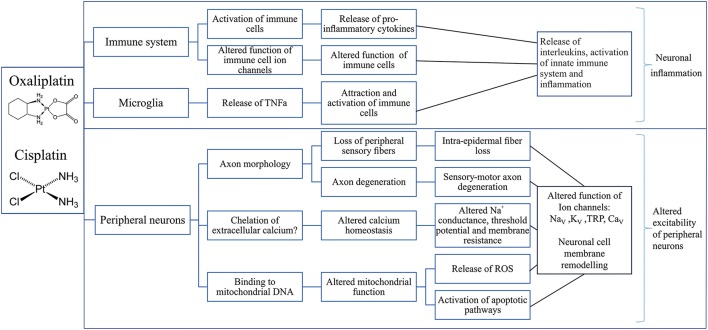Figure 2.
Putative mechanisms involved in the development of cisplatin- and oxaliplatin-induced peripheral neuropathy. Overview of possible effects of oxaliplatin and cisplatin on the immune system (Raghavendra et al., 2003; Callizot et al., 2008; Boyette-Davis and Dougherty, 2011; Wang et al., 2012; Di Cesare Mannelli et al., 2014; Janes et al., 2015), microglia (Di Cesare Mannelli et al., 2014) and peripheral neurons (Zwelling et al., 1979; Thompson et al., 1984; Faivre et al., 2003; Tomaszewski and Busselberg, 2007; Todd and Lippard, 2009; Tesniere et al., 2010; Alcindor and Beauger, 2011; Boyette-Davis and Dougherty, 2011; Deuis et al., 2013; Areti et al., 2014; Boehmerle et al., 2014; Dasari and Tchounwou, 2014; Canta et al., 2015; Leo et al., 2017) leading to neuronal inflammation (Janes et al., 2015) and altered neuronal excitability (Adelsberger et al., 2000; Krishnan et al., 2005; Kagiava et al., 2008; Gauchan et al., 2009; Ta et al., 2010; Descoeur et al., 2011; Nassini et al., 2011; Schulze et al., 2011; Sittl et al., 2012; Deuis et al., 2013, 2014; Yamamoto et al., 2015; Mizoguchi et al., 2016). TNFα, Tumor necrosis factor alpha; DNA, deoxyribonucleic acid; ROS, Reactive oxygen species; NaV, Voltage-gated sodium channel; KV, Voltage-gated potassium channel; TRP, Transient receptor potential channel; CaV, Voltage-gated calcium channel.

